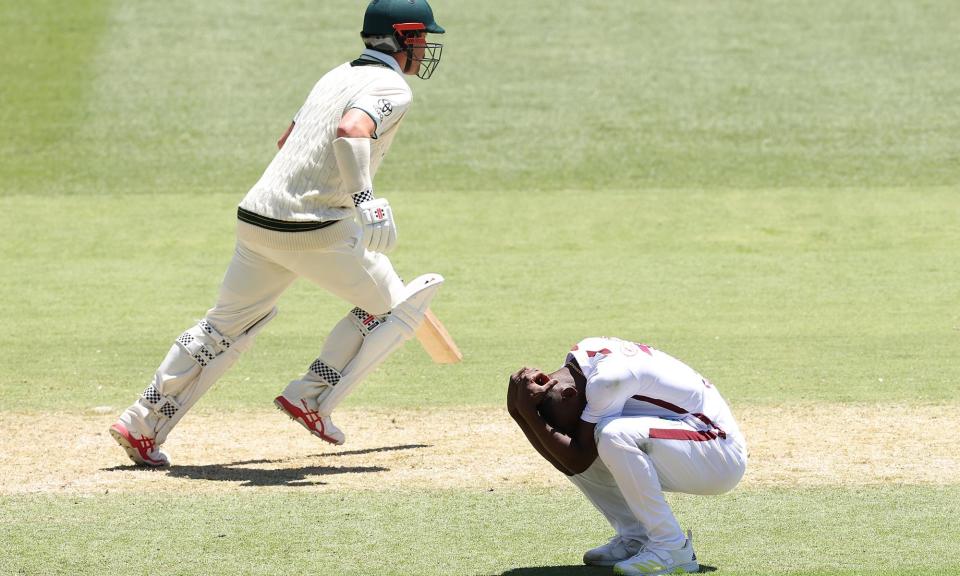Australia’s drubbing of once-great West Indies sad proof Test cricket mismatches must end

By now, we’ve done all the stories about West Indies cricket and its sad decline. Heard them, read them, written them. Tour after tour of pining for the past, mumbling the names of frightening former greats like a fast-bowling rosary. The thing is, after the current team got done by 10 wickets before lunch on day three at Adelaide, there was much less of this stuff. The glory days are so far behind us that even their lamentation has become vintage.
Fair enough, too. The start of the great West Indies era is nearly 50 years past. Even its last flickers in 1999 were a quarter of a century ago. One might as well pine for Richie Benaud bowling around the wicket at Old Trafford. By now Australia dishing out a heavy beating to the Caribbean team is just contemporary reality.
Related: In search of joy: West Indies cricket faces long rebuild after years of woe
There was no better example than the television broadcast closing with Brendon Julian’s closing mention that Australia had retained the Frank Worrell Trophy. The line was carefully enunciated to avoid the unfortunate spoonerism he produced after the corresponding series in 2015, but it was a quick aside just before heading to a long ad break and a match replay.
Compare that to 1995, when it was the biggest prize in the world for Australia, finally claiming it after West Indies teams had held it for eight series in a row. This is a trophy that was struck in the heat of public fervour for the brilliant West Indies visit of 1960-61. These days it’s an afterthought, its recipient decided after one match in this two-Test encounter that doesn’t deserve to be called a series.
West Indies’ women have played one Test in 45 years and will probably never play another. West Indies men are still functional at the lower end of the scale. They generally beat Zimbabwe and Bangladesh, have picked off a few against Pakistan and Sri Lanka, and somehow keep winning series against England when hosting, while picking off the odd Test while visiting.
But it’s nearly ten years since they beat New Zealand in a Test. The last time they beat South Africa was 2007. The last time they beat Australia was 2003. Against India it was 2002. The last time in Australia was 1997. Or look at it this way: West Indies’ last 50 Test wins take us back to the famous one at Kingston in 1999. West Indies’ last 50 losses only date back to Lord’s 2012.
So yes, there are good West Indies players who were missing from this team - but Shai Hope and Shimron Hetmyer and Nicholas Pooran and Jason Holder could all have been present in Adelaide and history suggests that the result would have been no different. These teams have been outmatched again and again. The general existential dilemma of Test cricket, of how to keep it healthy in places where it isn’t thriving, is being played out most starkly in the Caribbean.
The West Indies Cricket Board does put money into the format, from the allocation it has. But demographics have shifted, and priorities with them. There is little domestic first-class cricket to be played, and those matches now happen on slow spinning pitches. Players whose skills suit red-ball cricket have long lulls between brief assignments, while those who suit white-ball get hoovered up by T20 leagues. That will likely be the case for Shamar Joseph, the main bright point along with Kirk McKenzie in Adelaide.
“Nobody wants to see him today with the bat,” was the line from former champion Brian Lara before play on the first day, amusing given that Joseph’s 55-run partnership at No 11 ended up being the thing that for a time kept his team in a game. By the next day he had taken five wickets on debut and become a crowd favourite. On the third morning his bat was lashing West Indies into a lead.
It was great fun, but a player who can bowl a sharp bouncer, move the ball off the seam, and play a pull shot for six will be immediately in demand. Test cricket becomes the shop window, T20 the windowless multinational retailer. For a kid from a poor logging village in Guyana, he will surely have to take the offers that come in, unlike players on Australian contracts who can afford to turn some things down.
So while Josh Hazlewood can enjoy his nine wickets and Travis Head his hundred – the fruits of Test cricket are earned however much the difficulty might differ - it must be remembered that a mismatch has its origins off the field. It is encouraging that administrators from the few wealthy nations have recently been admitting that a problem exists, and even tentatively suggesting that something should be done to address it. What remains, as ever, is to translate the saying into doing.

 Yahoo Sport
Yahoo Sport 






































